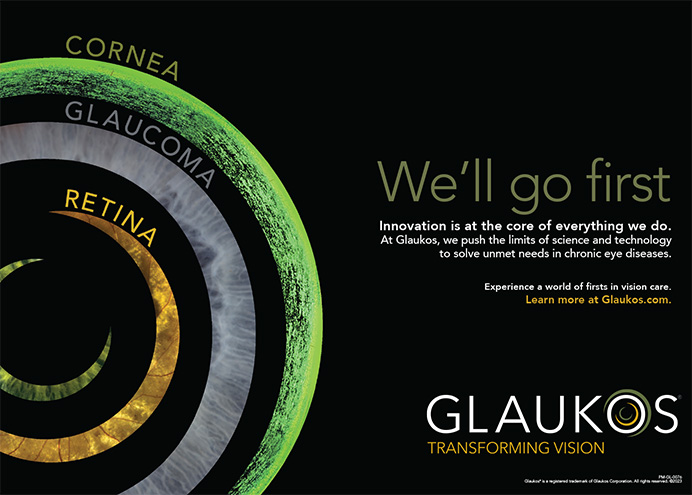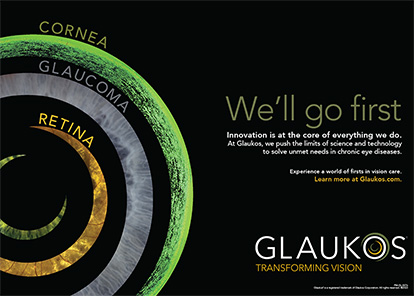As keratorefractive surgery has evolved, refractive surgeons' desire for procedures with a more attractive safety profile and without adverse results has led them to pursue minimally invasive, nonincisional techniques in carefully selected patients. These methods use radiofrequency energy (conductive keratoplasty [CK; Refractec, Inc., Irvine, CA]) or thermal energy (laser thermal keratoplasty [LTK; Sunrise Technologies International, Inc., Menlo Park, CA]) to promote midperipheral collagen shrinkage within the cornea. Surgeons may titrate a variable number of treatment spots according to the degree of hyperopia. By increasing the number of radial applications of energy in a single optical zone or by progressively making the optical zone smaller, the surgeon can augment the myopic shift.
The “belt-tightening” effect on the midperipheral cornea steepens the central corneal curvature and has yielded promising results for correcting low levels of spherical hyperopia. Nevertheless, we have found that some eyes treated with these modalities experience surgically induced regular and irregular astigmatism.
CASE EXAMPLE
A 47-year-old, healthy white male underwent uneventful CK with the ViewPoint CK System (Refractec Inc.) for +1.25 + 0.25 X 5. After instilling topical anesthesia, the surgeon created two circles of eight symmetrically placed treatment spots along the 7-mm optical zone. Postoperatively, the patient complained that his treated eye experienced persistent visual ghosting and blurring at all distances with and without spectacle correction. At 3 months, his UCVA was 20/25, while his BSCVA was 20/20 and 0.25 + 1.00 X 163. Corneal topography showed well-centered corneal steepening but central, surgically induced, irregular astigmatism (Figure 1).
Three years after the procedure, when the patient noticed no improvement in the ghosting and blurring (Figure 2), a successful RGP contact lens fitting resolved his symptoms. His UCVA is now 20/25, and his BSCVA is 20/20+ with a manifest refraction of +0.75 + 0.75 X 178.
CAUSATION
During collagen shrinking procedures, the asymmetric application of energy can surgically induce astigmatism. The asymmetry can result from inconsistencies in (1) the equipment, (2) the location of the energy application, (3) the depth of the energy application, and (4) the distance of the application from the central visual axis. Because deeper or more central applications of energy result in a more profound change in the corneal shape within the visual axis, they can cause a greater amount of visually significant surgically induced astigmatism.
During the FDA clinical trials using the Sunrise Hyperion LTK system (Sunrise Technologies International, Inc.) for +0.75 to +2.50 D of hyperopia, investigators reported early surgically induced astigmatism of greater than 2.00 D in 3.5% of the eyes at 1 month postoperatively. Some improvement occurred throughout the postoperative course. At 12 and 24 months, 0.2% and 0% of the eyes, respectively, demonstrated surgically induced astigmatism of greater than 2.00 D. In clinical trials using the ViewPoint CK System, surgically induced astigmatism of greater than 2.00 D occurred in 0.5% of eyes over a similar duration.
TREATING INDUCED ASTIGMATISMRegular
At Stanford University, we are currently evaluating the treatment of surgically induced regular astigmatism after LTK and CK. Our own experience suggests that spontaneous improvement occurs with time. Although the most significant change may take place within the first few postoperative months, improvement may continue for years. Theoretically, a physician should be able to treat stable, surgically induced regular astigmatism using direct excimer ablation or the additional application of CK or LTK energy to the flatter meridians. Nomograms for these enhancements have not been fully evaluated, however.
Irregular
As illustrated in the case described earlier, smaller amounts of surgically induced irregular astigmatism within the optical axis can cause the patient to experience significant, subjective symptoms despite minimal measured regular astigmatism. Effectively treating visually symptomatic irregular astigmatism resulting from LTK or CK may be difficult. Indirectly changing the central corneal curvature through the biomechanical effects of midperipheral collagen shrinkage may differ inherently from the direct ablative effects of the excimer laser.
Currently, investigators are using topographically guided customized ablation with or without a masking agent in order to study the treatment of irregular astigmatism resulting from direct excimer laser ablation.1-3 We know much less about the effect of this type of treatment on irregular astigmatism resulting from indirect keratorefractive surgery such as LTK and CK. Until studies further refine the treatment nomograms, we recommend conservative treatment with an RGP contact lens.
CONCLUSION
Collagen shrinking techniques offer several distinct advantages over traditional excimer laser ablative procedures such as PRK and LASIK. Both CK and LTK treatments occur outside the optical zone, are technically easier to perform, have a shallow surgical learning curve, are not associated with flap complications or central scarring, and do not result in tissue removal or compromise the cornea's underlying structural integrity.4 In addition, the CK and LTK units are more portable and less expensive than an excimer laser system.
Our understanding of the intricate and dynamic biomechanical characteristics of the cornea as it relates to collagen shrinking procedures still requires refinement, however. Greater clinical experience will better inform us how the controlled shrinkage of collagen within the corneal stroma can achieve keratorefractive effects.
Weldon W. Haw, MD, is Assistant Professor and Clinic Chief at the Department of Ophthalmology, Stanford University School of Medicine, California. He does not hold a financial interest in any of the technologies or companies mentioned herein. Dr. Haw may be reached at (650) 724-3734; whawhaw@hotmail.com.Edward E. Manche, MD, is Associate Professor and Director of Cornea and Refractive Surgery at the Department of Ophthalmology, Stanford University School of Medicine, California. He does not hold a financial interest in any of the technologies or companies mentioned herein. Dr. Manche may be reached at (650) 725-5743; mu.edm@forsythe.stanford.edu.
1. Knorz MC, Jendritza B. Topographically-guided laser in situ keratomileusis to treat corneal irregularities. Ophthalmology. 2000;107:1138-1143.
2. Gimbel HV, Stoll SB. Photorefractive keratectomy with customized segmental ablation to correct irregular astigmatism after laser in situ keratomileusis. J Refract Surg. 2001;17:2(suppl):229-232.
3. Alio JL, Belda JI, Shalaby AM. Correction of irregular astigmatism with excimer laser assisted by sodium hyaluronate. Ophthalmology. 2001;108:1246-1260.
4. Haw WW, Manche EE. Conductive keratoplasty and laser thermal keratoplasty. Int Ophthalmol Clin. 2002;42:99-106.


